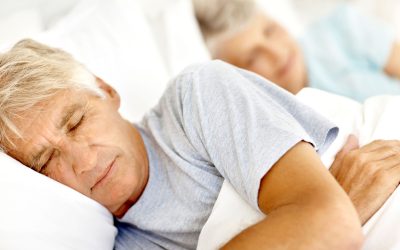Sleep, Recovery and Stress Management
Sleep, Recovery and Stress Management
Strategy: Make Sleep a Lifestyle Priority; We Can’t Live Well Without It!
Sleeping well in spite of aging
Poor sleep in old age prevents the brain from storing memories
By Yasmin Anwar University of California - Berkeley Findings suggest boosting 'slow wave' sleep could restore memory as we age The connection between poor sleep, memory loss and brain deterioration as we grow older has been elusive. But for the first time, scientists...
At What Age Should We Start battling the Aging Process?
Well, I would call it the Age of Awareness - it's that first time we look in a mirror and realize things are a-changing for the worse. Usually it shows as a slow buildup of mid body fat for men - they haven't yet noticed loss of muscle, but it's happening. For the...
Sleep – A Top Priority in Your Senior Fitness Program
In our Anti-aging category we discuss the impact of inflammation on the aging process, and how it seems to underlie many of the disease conditions that eventually take us down the final slope of life. Now there is word that even one bad night's sleep increases a major...
Sleep, Recovery and Stress Management – Time for mind and body to repair and strengthen.
Exercise Recovery:
Systemic recovery refers to secession of post-workout fatigue; it is the recovery of the central nervous and endocrine systems, and the clear sign is a sense of feeling energetic again. In both instances, the older we are, the longer it takes, but the better our overall health, the faster we recover. You can’t do dead-lifts or squats on Friday afternoon and then dig ditches Saturday morning. You will be hammered for days and maybe injured, because you haven’t allowed time for either systemic or local recovery. A Heavy workout for back and legs requires 5-7 days to recover from before you can put any serious stress on those body parts. Don’t do protracted aerobics on the same day you train with weights because it will drag you down systemically; your body will go catabolic and tear down muscle instead of building it. I suggest that you can do light aerobics the next day, but don’t try to run a 10K.
Most popular literature urges us to exercise three days a week – typically Monday Wednesday, Friday – but the best results happen when heavily taxed muscles are given over a week to recover and grow bigger. Allowing longer recovery is falsely thought to reduce muscle gains; not so; I have made measurable gains in strength and size with 22 days between working the same body parts. (Look back at my Exercise article to see examples of how to work different parts of the body on separate days to allow better recovery). A whole class of pre- and post-workout products (mostly drinks) has developed to aid in enhancing energy and motivation before workouts and restoring energy levels after a workout. They really help us seniors attack our workouts and bounce back after. One of my favorites, providing electrolytes, Deer Antler Velvet and enhanced nitric oxide production, and all the right stuff to drive these into your muscles before a workout, is DAS Labs’ Bucked Up. For stronger, better functioning muscles I like Creatine HCl by SNS also taken pre-workout. I’ve had terrific results with these two.
Using a post-workout protein drink will dramatically improve recovery. There is a window of about 1 hour after intense training to get amino acids into those hammered muscles, allowing optimum protein synthesis to start the rebuilding process. Taking an amino acid complex is the fastest way to get the muscles fed, bypassing the digestive process. My favorite brand these days is Primeval Labs EAA Max.
Strategy: Space your bodybuilding workouts to allow local and systemic recovery. Use a recovery drink immediately after workouts. Don’t let your lifestyle put you into a state of chronic fatigue. Lasting fatigue usually indicates overtraining or a poor sleep pattern that prevents optimal repair.
Sleep:
Most of the reconstructive work our body does happens while we sleep. Deprive ourselves of this vital activity and we will, to some degree, age more rapidly and decrease our performance in virtually every aspect of life. Yet, one or the biggest complaints of our senior population is that we don’t sleep well, we don’t feel rested when we do and don’t have adequate energy when we’re awake. Recent science has show that just a few nights of insufficient or poor quality sleep starts one on the path to metabolic syndrome. A pattern of cheating on sleep is the fastest way to weight gain and promotes type-2 diabetes.
Any experience of chronic fatigue indicates possible impairment of the HPTA axis – the interlinked operation of the Hypothalamus, Pituitary, Thyroid, Adrenal system of glands. Impairment or exhaustion of any of these can lead to faulty operation of the others, and a reduced capacity to handle stress and produce energy for the operation of any of the body’s systems. The fastest way to induce HPTA impairment is to get insufficient or poor quality sleep. Here are some suggestions for getting enough sleep, the best sleep quality, and how to promote and improve the body’s various repair mechanisms to have the waking energy to live life to the max.
First, do not use prescription sleep medications – they are all addictive and scramble normal neurotransmitter balance. Occasional use when normal routine is disturbed may not hurt, but we need to learn how to sleep without drugs. Alcohol, will make us drowsy, but destroys the quality and benefit from the sleep obtained; go to bed sober. Alcohol increases brain levels of histamine, which promotes alertness, not sleep, so when the alcohol wears off, a full bladder and the resulting alertness, can prevent resuming sleep for hours.
Second, there are nutrients which aid in naturally sleeping well. Look for combinations of these in a product: hops, passion flower, valerian, lemon balm, chamomile, verbena. Add to these 5-HTP (200 mg), L-Theanine (200mg), magnesium (I prefer Mg Malate, up to 600 mg), inositol, biotin and melatonin (< 3mg for most folks). In addition, I use GABA (gamma aminobutyric acid) which is an inhibitory neurotransmitter available typically in 750 or 500 mg doses. It rapidly quiets any agitation or anxiety and promotes sound, solid sleep with proper REM intervals. These all work to improve brain chemistry involved in sleep and recovery processes.
Sleep and wake are two distinct mental states controlled by two areas of the brain: the Orexin System (OS) and the Ventrolateral Pre-Optic Nucleus (VLPO). The OS keeps us awake the VLPO puts us to sleep by suppressing the OS neurons. All the substances mentioned above activate the VLPO and are part of the natural mechanism for going to sleep; we are just augmenting our own production of these elements and improving the process. Take these an hour before lights out on an empty stomach. One more thing; histamine excites the OS, while antihistamines help shut down the OS, that’s why they make us drowsy.
Recently, numerous studies have revealed that anticholinergic antihistamines (most of those available OTC) disrupt memory formation during sleep and appear to impair cognitive function, promoting earlier onset of some forms of dementia. I have been using various antihistamines for decades to get to sleep and am looking for alternatives, hopefully that block or reduce histamine production in the brain.
One possibility is boosting brain levels and/or activity of Histamine-N-methyltransferase, an enzyme that breaks down histamine, regulating healthy levels. The enzyme proves to be critical for proper regulation of sleep-wake behavior. Its function is SAM-e dependent, so raising brain levels of SAM-e facilitates its function. Methionine, taken as a supplement, raises brain SAM-e levels more efficiently than taking SAM-e, and at lower doses and cheaper. I’m seeing doses of 0.5 to 1.0 g/day in the literature.
Third, start winding down, dimming the lights and quieting the mind 2 hours before bed. Don’t watch thriller TV or read exciting books as the last thing of the day and put business and disputes aside early. Take the last hour to do the hygiene stuff, spend a half hour in prayer with low lighting and conk out.
Strategy: Order your life to get 7-8 hours sleep on a daily basis to feel energized and avoid fatigue. Use nutrients to aid sleep – avoid drugs and late-night alcohol, shut down the excitement early, dim the lights, use prayer or meditation to calm the soul before lights out.
Another powerful product for stimulating repair and recovery is Animal PM. Taken at night on an empty stomach, it coaxes the pituitary gland to secrete increased levels of Human Growth Hormone (HGH) while you sleep. The results, from personal experience, are profound – better sleep, feel and act like a kid, increased daytime energy, fat stores drop significantly, and recovery from a serious workout day is well underway by morning. Another comparable product I am familiar with is Chemix Sleep, and it has a GABA receptor agonist in the formula, so makes sleep easy, while releasing HGH at the appropriate time. . A very positive result of using these sleep products is that increased HGH will make fat evaporate on its own, like you were 20 years younger.
Recreation and Rest:
The other facet of recovery is the relaxation time we want in each day to smell the roses or whatever else recharges your batteries for the next activity. Yes, it would be good to be the Energizer Bunny all the time, but pushing beyond fatigue is a stress that tears you down. The hallmark of aging is reduced energy production – our mitochondria are running out of steam and simply can’t produce ATP at youthful rates, so activities have to be chosen that give the most benefit for the associated output of energy. Fatigue is a warning that your energy production is unable to keep pace with your activity level. Often all it takes is to lie down and shut your eyes for a few minutes, and life is SO much better. It is important to make space in life for rest and restful activities, while making recovery a conscious part of living life to the fullest. For some, a change of activity is as good as a rest. But we need periods of enjoyable, restful activity to allow energy production to catch up.
Strategy: Listen seriously to your fatigue; curtail activities and take a rest or nap when it hits you. Purposefully make ample time for enjoyable and pleasurable activities that are recuperative. Balance activity level with energy output to prevent protracted fatigue.
An important benefit of recovery/rest is the reduction of stress, especially chronic stress that continually tears you down. There is a balance to be struck in life. We have the old imperative – use it or lose it – which speaks of the need to challenge our limits and keep growing as a person, but that must be balanced against the reality that we are all slowly wearing out. If we don’t purposefully avoid constant/chronic fatigue, we wear out much faster, with far less enjoyment.
Good Living – Frank


